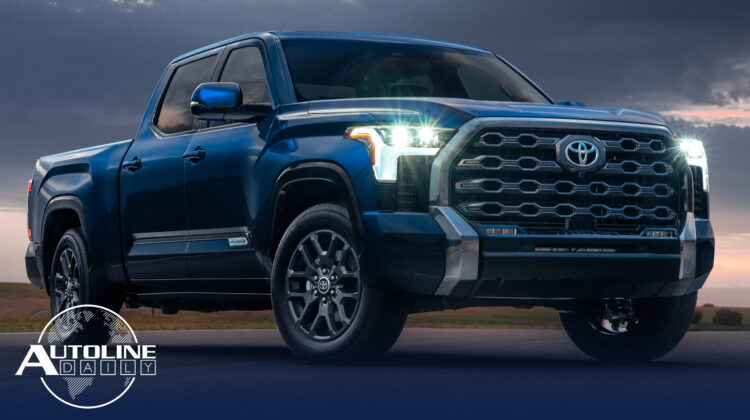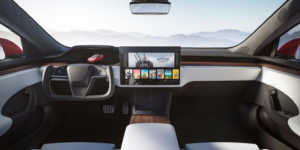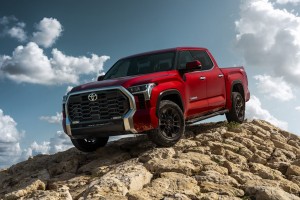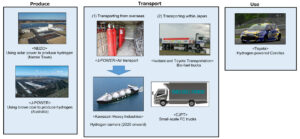

Follow us on social media:
Runtime: 11:16
0:07 CR Criticizes Tesla’s Yoke Steering Wheel
1:12 Biden Admin Tightening Emission Standards
2:18 NHTSA Opens New Investigation into Takata Airbags
3:39 All-New Toyota Tundra Details Emerging
6:10 Toyota Tests Hydrogen Transport
7:09 Honda Reveals Prologue Production Targets
7:47 Honda Says It Won’t Hit Production Targets w/o Fair EV Incentives
9:23 Tesla’s China Exports Booming
10:00 China Worried About Foreign-Sourced Microprocessors
Visit our sponsors to thank them for their support of Autoline Daily: Bridgestone, Intrepid Control Systems, Magna and Schaeffler.
This is Autoline Daily, the show dedicated to enthusiasts of the global automotive industry.
CR CRITICIZES TESLA’S YOKE STEERING WHEEL
Consumer Reports hates that steering yoke on the new Tesla Model S and X. Ten different testers drove the new Model S and had a hard time getting used to it. Some complained it slipped out of their hands. Others found gripping the handles made their hands ache and others had trouble making turns. They also had issues using the flat, touch sensitive buttons on the yoke that replace the turn signals and windshield wipers. The buttons also activate the horn and high beams. The drivers would accidently hit the buttons or have to look at the yoke to know what button they wanted to push. But Consumer Reports did have one good thing to say, that the yoke made it easier to read the instrument cluster behind the wheel. And CR did admit that this is only their initial impression and they will likely get used to it the more they drive it. We agree. Formula 1 and IndyCars have used yokes for years, so people will learn to deal with it.
BIDEN ADMIN TIGHTENING EMISSION STANDARDS
The Biden Administration is tightening up emission standards on ICE vehicles. Automakers have to start reducing tailpipe emissions for light duty vehicles by 5% a year starting right now, running through 2026. That kind of caught automakers by surprise. And while 5% a year may not sound like a lot, it is. And it’s going to drive up the cost of ICE vehicles which will make EVs more competitive. In 2027, the Administration wants drastic reductions in tailpipe emissions and the EPA is now asking for comments on those regulations. We got this info from the SAE’s North American International Propulsion Conference, which follows Chatham House rules. That means we’re free to use any information that came out of that conference, but we can’t tell you who said it or what company or organization they work for. But you can take it from us: these new regulations are real.
NHTSA ANNOUNCES NEW INVESTIGATION INTO TAKATA AIRBAGS
NHTSA announced its opening a new investigation into potentially defective Takata airbags. The probe involves 30 million vehicles built by nearly two dozen automakers from model years 2001 to 2019. The issue once again involves the bag’s inflators and includes both vehicles that had the inflators installed when they were built and inflators used in previous recall repairs. While NHTSA says there isn’t a present safety risk, it needs to study the long-term safety of the inflators. The previous Takata airbag recall resulted in 67 million vehicles being called in for repairs, the largest in history.
ALL-NEW TOYOTA TUNDRA DETAILS EMERGING
Meet the 2022 Toyota Tundra, which is all-new from the ground up. One thing’s for sure, Toyota really studied the F-150, the Silverado and the Ram when it went to work on the new Tundra. So, starting from the ground up, the Tundra features a new high-strength steel frame. Bolted to that is a newly developed front suspension system and a new multi-link rear suspension, which, like the Ram, replaces leaf springs with coil springs. Active dampers are also available for the first time. The setup allows for maximum towing of 12,000 lbs, an increase of over 17.5%, and max payload of nearly 2,000 lbs. Just like the F-150, with its EcoBoost engine, the Tundra gets a twin-turbo 3.5L V6 engine that’s standard. It puts out 389 horsepower and 479 lb-ft of torque. A hybrid is also available. It uses the same engine, but with a hybrid motor/generator mounted between the engine and transmission, which is a 10-speed unit for both setups, and it gets a Nickel-Metal Hydride battery located under the rear seats. That’s cheaper than a lithium battery and while it’s also heavier, weight doesn’t matter as much in a big pickup. The hybrid generates 437 horsepower and 583 lb-ft of torque. The interior design, we’d say, is a little like the exterior design; rugged mixed with a little bit of technology and sophistication. It’s highlighted by an available 14-inch display screen, but, so you know, an 8-inch screen is standard. As for the exterior, all of the Tundra’s accessories look clamped or bolted down, which adds to the ruggedness. Also note how it has that similar design element to the Corolla Cross where the body color cuts into the bottom of the wheel arches that appear to clamp the body down to the wheels. The TRD model adds a number of exclusive design elements and off-road components as well. And in total, there’s two cab and three bed lengths available. And speaking of the bed, it’s made of a composite material reinforced with aluminum. The all-new Tundra will be on sale before the year is out.
TOYOTA TESTING HYDROGEN TRANSPORT
And while we’re on the subject of Toyota, it continues to try and learn the challenges of a hydrogen society through its racing efforts. In its first two stints with hydrogen-powered race cars, Toyota tested the “use” of hydrogen, then the “producing” of hydrogen. And now it wants to test the “transporting” of hydrogen. The hydrogen used to power the race cars will be produced from Australian lignite, or brown coal. And then be transported to Japan using the world’s first liquified hydrogen carrier ship, which was built by Kawasaki. To ensure it’s a completely “clean” supply chain, the fuel will be transported to the race with bio-fuel and fuel-cell electric trucks. Toyota says it also has plans to use the hydrogen transported from Australia by the mid-2025’s in its efforts to help realize a hydrogen society.
HONDA REVEALS PROLOGUE PRODUCTION TARGETS
Honda announced it plans to sell 70,000 units annually of its all-electric Prologue SUV when it launches in 2024. The Prologue is being co-developed with General Motors and is based on GM’s Ultium platform. GM will also build the Prologue along with another electric SUV for Acura. Honda also plans to introduce EVs built on its own architecture after the launch of the Prologue. The automaker said it plans to sell half a million BEVs in North America by 2030 and be 100% zero-emission by 2040.
HONDA SAYS IT WON’T HIT EV GOALS WITHOUT FAIR EV INCENTIVES
Honda is also complaining about the Biden Administration’s proposal to give extra incentives for EVs made with UAW labor. So that makes us wonder if the Prologue will get those extra incentives, since GM will make the Prologue with UAW labor. But we also think it’s unfair to American workers who make electric cars who do not belong to the UAW to be penalized. The UAW has been wracked by corruption and its two past presidents along with a number of officers are now in federal prisons. While we’re not against unions, you can’t penalize workers who do not want to belong to an organization like that.
TESLA’S CHINA EXPORTS BOOMING
Tesla’s exports from China are booming. From January to August, it exported over 97,000 cars from China–even to the U.S. market. It’s the first time we heard about Chinese Teslas going to the U.S., but that’s according to Tesla China. In fact, through June, Tesla accounted for one out of every three electric cars exported from China this year, according to the China Passenger Car Association. Tesla announced a couple of months ago that it was going to use its Gigafactory Shanghai as its global export assembly plant.
CHINA WORRIED ABOUT FOREIGN-SOURCED MICROPROCESSORS
The U.S. and EU aren’t the only ones worried they depend too much on foreign countries for microprocessors. So is China. It has to import 95% of the chips used for connected and autonomous cars. That’s according to a former government official from the MIIT, or Ministry of Industry and Information Technology. Even more, the software for safety systems comes from outside of China. And the software to design, develop and verify chip designs comes from American and European companies. The former MIIT official also says China has to protect itself from external shocks.
But that brings us to the end of today’s show. Thanks for tuning in and we’ll be right back here again tomorrow.
Thanks to our partner for embedding Autoline Daily on its website: WardsAuto.com
Seamus and Sean McElroy cover the latest news in the automotive industry for Autoline Daily.









